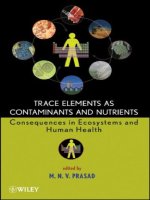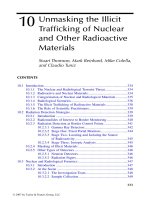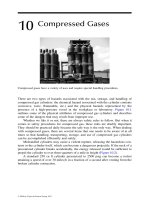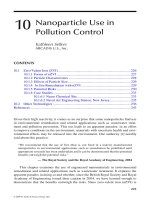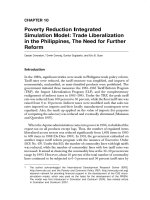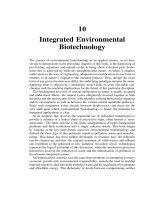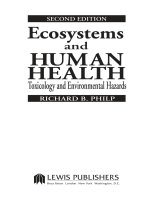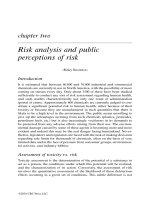Ecosystems and Human Health - Chapter 10 pps
Bạn đang xem bản rút gọn của tài liệu. Xem và tải ngay bản đầy đủ của tài liệu tại đây (59.22 KB, 15 trang )
©2001 CRC Press LLC
chapter ten
Mycotoxins and other toxins
from unicellular organisms
Anything green, that grew out of the mould,
Was a wonderful drug to our fathers of old.
— Anonymous
Introduction
Mycotoxins are a group of chemically diverse and complex substances
present in a wide variety of filamentous fungi (molds). They are secondary
metabolites of fungal metabolism of uncertain function. Some may have a
survival advantage by virtue of their toxicity to competing organisms in
the microenvironment. The biological function of others is unclear, but
many have significant biological activity and several are toxic to mammals.
They therefore have significant public health and economic implications.
It is estimated that 25% of the world's annual food crops are contaminated
by mycotoxins.
Some mycotoxins are of interest to pharmacologists and toxicologists
because they have served as research tools to study cell function and to
identify various types of neurotransmitters and blocking agents. Poisonous
mushrooms are solid (not filamentous), spore-forming fungi that also con-
stitute a health hazard and which have historic, pharmacological signifi-
cance, but they are considered separately in Chapter 11.
Some human health problems due to mycotoxins
Reports of toxicity from molds are as old as recorded history.
Ergotism
The oldest recorded source of fungus poisoning is ergotism. Ergot is the
common name for the fungus
Claviceps purpurpea
that affects cereal grains,
especially rye, and that produces a number of very potent pharmacologically
©2001 CRC Press LLC
active agents that cause toxic reactions when people eat bread made from
contaminated flour. Periodic epidemics of ergotism have occurred through-
out history, and in medieval times these were often attributed to supernatural
causes. The earliest reference to ergot seems to have been on an Assyrian
tablet circa 6000 B.C. which refers to “a noxious pustule in the ear of grain.”
The Parsees, an ancient religious community in India, referred in their writ-
ings to noxious grasses that caused women to abort and to die shortly
thereafter. The ancient Greeks escaped the scourge of ergotism because they
never developed a taste for rye bread, which they referred to by a phrase
that translates roughly as “that filthy Macedonian muck.” Because rye bread
did not reach Europe until after the decline of the Roman Empire, few if any
references to ergotism exist in Roman writings.
There was an early association of ergot with St. Anthony of Egypt, who
lived sometime between 250 and 350 A.D. St. Anthony is considered to be
the founder of Christian monastic life and spent long sojourns in the desert,
experiencing visions and hallucinations. These frequently involved attacks
by Satan in various guises (wild beasts, soldiers, and women) that either
physically attacked him or tempted him. Contemporary witnesses claimed
that he behaved like an individual being physically abused. Because the
signs and symptoms of ergot poisoning resembled his attacks, sufferers in
the Middle Ages attached religious significance to them and they came to
be known as “St. Anthony's Fire” (or sometimes “Holy Fire”). In 1100, the
Monastery of the Hospitillers of St. Anthony was established at La Motte in
France. It became the site of pilgrimages by those afflicted with this malady.
The signs and symptoms included intense burning pain in the extremities
followed by a blackened, necrotic appearance; hence the association with
fire. Epidemics of madness in the Middle Ages may also have been the result
of ergotism.
Ergot was employed as an abortifacient long before it was known to be
the cause of St. Anthony's Fire, and this use continued well into the nine-
teenth century when it was finally abandoned because of its highly toxic
nature. One of the components of ergot is still employed to stop
postpartum
hemorrhage because it constricts blood vessels and contracts the uterus. To
summarize, the symptoms of ergotism include drowsiness, nausea, vomit-
ing, muscle twitch, staggering, gangrene, hallucinations, and abortion. Ergot
contains a veritable potpourri of pharmacological agents that were charac-
terized by Sir Henry Dale in the early 1900s and contributed to the devel-
opment of many new drugs.
The active components of ergot, the ergot alkaloids, are all derivatives
of lysergic acid. They bear some molecular resemblance to adrenaline (epi-
nephrine), dopamine, and serotonin — all central neurotransmitters. Meth-
ysergide is the precursor of LSD. Two derivatives still have medicinal appli-
cation. Ergometrine (ergonovine) is the one used to control
postpartum
bleeding. Ergotamine is a powerful vasoconstrictor responsible for the gan-
grene of ergotism. In very small doses it can be used to treat migrane.
©2001 CRC Press LLC
Ergotism also affects farm livestock, causing similar signs and, in addition,
loss of milk production in cattle and necrotic combs, feet, and beaks
in poultry.
Aleukia
Aleukia (literally “absence of white cells”) occurs when millet and other
grains that have become moldy are consumed. The toxin is a tricothecene
from species of Fusarium and it damages bone marrow. Because of severe
food shortages in Russia during World War II, the eating of moldy grain
resulted in several epidemics of aleukia, including a very large one in 1944.
The mortality rate of those with marrow damage was 60%. Other symptoms
included hemorrhages in the skin and mucous membranes. The condition
is also referred to as alimentary toxic aleukia.
Aflatoxins
Aflatoxins are a family of heterocyclic, oxygen-containing compounds
secreted by the molds
Aspergillus flavus
and
A. parasiticus
. These molds grow
abundantly on many kinds of plants in very hot conditions. Peanuts are
especially prone to infection. Taste is not affected and the toxins are heat
stable. Aflatoxin B
1
(AFB
1
) is the most frequently encountered member of
the group and it is a potent carcinogen in experimental animals (rodents,
birds, and fish). Rats fed a diet containing 15 ppb AFB
1
develop hepatitis,
which is often followed by cancer of the liver. Epidemiological studies of
populations in Uganda, Kenya, and Thailand have shown a close correlation
between the incidence of liver cancer and the consumption of food contain-
ing aflatoxins. It is estimated that the risk factor for liver cancer is increased
10 times by AFB
1
. Infectious hepatitis also increases the risk by a factor of 10.
If present together, the risk is increased 100-fold. Other aflatoxins include
B
2
, G
1
, and G
2
. Lactating cattle excrete hydroxylated metabolites M
1
and M
2
in milk. These have lower toxicity than the parent compounds but are of
concern because of the large amount of milk consumed by infants and
young children.
Thus, this natural carcinogen, at least as potent as TCDD in animal
studies, is strongly implicated as a cause of human cancer, unlike the latter
synthetic agent, that has received much more media coverage. Experiments
employing human liver microsomal preparations indicate that cytochrome
P450 (Cyp) 3A4 is largely responsible for the formation from AFB
1
of the
8,9-
endo
-epoxide, a genotoxic metabolite. Cyp 1A2 also forms this epoxide
but is much less active. It forms other, nongenotoxic metabolites and thus
may play a role in detoxification. An inhibitor of Cyp 1A2, alpha-naphthofla-
vone, increased the formation of the 8,9-epoxide. The
exo
-epoxide of AFB
1
(i.e., preformed before ingestion) is detoxified by conjugation with glu-
tathione. Experimental evidence suggests that species differences in toxicity
are due to differences in the rate and extent of conjugation with glutathione.
©2001 CRC Press LLC
Whereas rat liver cytosol conjugated endo-epoxide, mouse liver cytosol con-
jugated the
exo
-epoxide almost exclusively and both were much more active
than the cytosol of human liver cells. The mucus cells of the intestine also
make the 8,9-epoxide, but because they are sloughed frequently, this does
not constitute a risk factor for cancer.
Other aflatoxins found together are B
2
, G
1
, and G
2
. Acute toxicity also
can occur in humans. In 1974, an outbreak in India resulted in about 100
deaths, and in Kenya 12 died in an outbreak in the early 1980s.
The aflatoxin story began in 1960 with a serious and mysterious outbreak
of a disease in turkeys in Great Britain. Turkey poults developed loss of
appetite, feeble fluttering, lethargy, and frequently died within a few days.
Necropsies revealed hemorrhage and necrosis of the liver and kidney. The
disease was dubbed “X” disease. Outbreaks also occurred in ducklings in
Europe, the United Kingdom, and Africa. The common denominator was
groundnut (peanut) meal used as feed and subsequently shown to be con-
taminated with
A. flavus
. Livestock (mammals) may also be affected. Death
has occurred in humans consuming an estimated 6 mg/day of aflatoxin B
1
.
In North America, there is concern about the long-term effects of con-
suming low levels of aflatoxins and monitoring systems are in place. Fortu-
nately, the mold is not adapted to the colder northern climate so that Cana-
dian-grown peanuts are free of the toxins. The majority of peanuts and
peanut butter are still imported from subtropical climes, however. Peanuts
are not the only source of these toxins. Because of drought conditions in the
United States in the summer of 1988, up to 30% of the corn crop may have
been contaminated. The Quaker Oats Co. was turning away almost one
truckload in five at its Cedar Rapids (Iowa) plant in the fall of 1988. The
company tests six samples from each truck. Inspections of the 340,000 tons
of corn crossing the Canada–U.S. border annually were stepped up in
1988–1989 by Agriculture Canada. The general structure of aflatoxins is
shown in Figure 37.
Fumonisins
Produced by
Fusarium monilforme
and
F. proliferatum
, these mycotoxins are
ubiquitous in many parts of the world, including South Africa where they
were first identified and many states bordering the Great Lakes. All of the
fumonisins (FB
1
, FB
2
, FB
3
) are potentially carcinogenic. Many experts feel
that it will become the most significant mycotoxin for human health. FB
1
has
been shown to be carcinogenic for animals (a promoter and initiator of liver
cancer in rats), and there is a high degree of correlation between the incidence
of esophageal cancer in humans and the presence of FB
1
in corn in specific
areas of South Africa. The fungus infects corn, millet, sorghum, and rice
around the world. Fumonisins are toxic for many species of animals, espe-
cially horses, and outbreaks have caused numerous deaths in horses and
©2001 CRC Press LLC
swine in Texas, Iowa, and Arizona. Severely infected corncobs may contain
up to 900 mg/kg. Symptomatology in various species is as folllows:
•
Swine
: vomiting, convulsions, sudden death, abortion, pulmonary
edema (porcine pulmonary edema syndrome). Symptoms may
occur at levels above 20 to 50 mg/kg of FB
1
.
•
Poultry
: ataxia, paralysis, sudden death, stunted growth. Toxicosis
occurs at levels of contamination of 10 to 25 mg/kg of FB
1
.
•
Cattle
: poor weight gain, liver damage.
•
Horses
: equine leukoencephalomalacia (ELEM), brain degenera-
tion with focal necrosis, blindness, wild behavior, liver damage,
staggering, ataxia. Symptoms may occur at levels of 10 mg FB
1
/kg
over 40 days.
FB
1
, FB
2
, and hydrolyzed FB
1
have been shown to be specific inhibitors
of
de novo
sphingolipid synthesis and sphingolipid turnover. FB
1
has been
shown to inhibit sphingosine (sphinganine) N-acetyltransferase, leading to
the accumulation of sphyngoid bases. This has been shown to stimulate DNA
synthesis, and it is hypothesized that this interference with normal cell
function could account for the toxicity of fumonisins.
The fumonisins are themselves analogs of sphingosine, with structural
similarities to the phorbol esters, which are known carcinogens (see
Chapter 11). The general structure of fumonisins is shown in Figure 37.
Figure 37
Chemical structures of aflatoxins and fumonisins.
O
O
O
O
AFB
1
R1 R3
R2R1
CH3
NH2
CH3CH3
OH
AFB
1 8,9-Epoxide
O
CH
3O
O
O
O
O
O
O
CH
3O
Fumonisin B1: R1 = 0-PTCA*, R2 = R3 = OH
Fumonisin B
2: R1 = 0-PTCA, R2 = H, R3 = OH
*PTCA = Propanetricarboxylic acid
©2001 CRC Press LLC
Other mycotoxic hazards to human health
Several mycotoxins may be potential health hazards by virtue of direct toxic
effects or because of carcinogenic or teratogenic properties, although it must
be emphasized that hard evidence linking these to human health problems
is scanty. Ochratoxin A is formed by
Aspergillus
and
Penicillium
species. It
has been shown to be embryotoxic and teratogenic in several laboratory
species of mammals (pig, dog, mouse, rat) and birds and is therefore viewed
as a potential human teratogen. Acute effects in animals (including swine
and poultry) include renal and hepatic destruction. Both humoral and cel-
lular immune systems are adversely affected. Contamination of bread and
cereals has been documented in parts of central Europe (Yugoslavia, Bul-
garia, Poland, and Germany) and levels have been detected in human milk,
urine, blood, and kidneys.
Patulin is potentially a carcinogenic toxin produced by several species
of fungi, including some
Penicillium
spp. It is a highly potent inhibitor of
RNA polymerase, having a strong affinity for sulfhydryl groups. It therefore
inhibits many enzymes. Teratogenicity has not been demonstrated in mam-
mals but embryolethality occurs at higher doses (2 mg/kg i.p.). A common
source of patulin is
Penicillium expansum
, a common spoilage microorganism
in apples. Apple juice can sometimes contain significant amounts of patulin.
Acute toxicity in rodents is manifested primarily as gastrointestinal symp-
toms, including hemorrhage. Carcinogenicity studies in rats were negative,
but clastogenic activity has been shown in some systems.
T-2 toxin is produced by various
Fusaria
and is both potent and common.
It inhibits protein and DNA synthesis and is therefore potentially teratogenic
and carcinogenic. Acute effects include loss of appetite and vomiting.
Fungi tend to produce mixtures of toxins so that exposure to a single
agent is unlikely to occur. There is some experimental evidence that ochra-
toxin A potentiates the teratogenic effects of T-2. It must be emphasized that
any mycotoxin that has been shown to be toxic in several mammalian
species (including various farm livestock) must be regarded as potentially
toxic for humans.
Economic impact of mycotoxins
In addition to their direct effects on human health, mycotoxins have a tre-
mendous impact on agriculture. Through spoilage, field crops are rendered
useless for animal or human consumption (the loss of 20% of the corn crop
noted above is one example). Poor weight gain and outright illness occur in
livestock that consume contaminated feeds. Losses are difficult to estimate
but they undoubtedly run to many millions and possibly billions of dollars
in North America. The presence of trace quantities in meat, dairy products,
and eggs constitutes a further, if largely unconfirmed, health hazard to
people. In the Great Lakes basin, various species of
Fusarium
are the most
©2001 CRC Press LLC
common offenders, especially in eastern Canada. They may produce a host
of toxins with potent pharmacological actions.
Fusarium life cycle
Fusarium graminearum
is the fungus responsible for maize ear rot in corn and
head blight in wheat. Its life cycle is typical of all
Fusaria
. Spores survive in
crop debris from the previous season (stubble, stalks and seeds) to re-infect
the next year's crop. Intensive farming practices that involve planting suscep-
tible species in the same fields year after year thus favor the spread of infec-
tion. Birds such as starlings and red-winged blackbirds, which puncture the
corn kernels to eat the milk, may also spread spores. Insects such as the picnic
or corn-sap beetle seek out damaged kernels and also may spread spores.
Certain weather conditions favor the spread of infection. Fungus growth
is favored by warmth (15 to 35°C) and by surface wetness for more than
48 hr. After the infection is established, weather is not critical to the produc-
tion of the toxin. Mold growth will continue throughout the season, and
even afterward if not properly dried or if storage conditions are poor (too
damp, too warm, poor air circulation). Mold growth can even occur during
feed preparation and in poorly cleaned feed troughs. Late harvest may allow
the growth of another fungus,
F. sporotrichiodes
, which produces the toxins
T-2, HT-2, and diacetoxyscirpenol.
Contaminated grains thus will contain complex mixtures of toxins
and metabolites. The following is a list of the other important ones and
their effects.
Trichothecenes
Zearalonone
This estrogen-like toxin causes (in swine) swollen, red vulva, vaginal and
rectal prolapse, vulval enlargement in piglets, and fertility problems. Devel-
opmental defects and lethality have been shown in some laboratory species.
Vomitoxin (deoxynivalenol or DON)
This trichothecene causes decreased feed intake and reduced weight gain
in pigs at about 2 mg/kg of feed, vomiting, and refusal of feed at very
high concentrations (>20 mg/kg feed). DON will be used as a “prototype”
mycotoxin to illustrate agricultural problems associated with these agents
(see below).
Species differences in DON toxicokinetics
Swine appear to be much more sensitive to the anorexic and weight loss
effects of DON than ruminants (cattle, sheep) or poultry, which are very
©2001 CRC Press LLC
tolerant. In one study, laying hens actually preferred a diet containing 5 ppm
DON in preference to clean feed. These differences are due, in part, to
differences in absorption and, in part, to differences in biotransformation
and elimination. Studies with radiolabeled DON indicated that sheep
absorbed 9% or less of an orally administered dose, in turkeys 20% or less
was absorbed, whereas pigs absorbed up to 85% of a single oral dose.
Intravenous administration of radiolabeled DON in sheep revealed an
initial distribution phase (t
1/2
= 18 min) followed by an elimination phase
(t
1/2
= 66 min). A glucuronide conjugate was formed and comprised 15 to
20% of plasma levels. In turkeys there was an extremely rapid distribution
phase (t
1/2
= 3.6 min), a rapid elimination phase (t
1/2
= 46 min), and the
formation of a conjugate (probably glucuronide) comprising up to 10% of
the total dose. Again, swine showed a much different picture. There was a
very rapid distribution phase (t
1/2
= 5.8 min), a secondary slower distribution
phase (t
1/2
= 96.7 min), and a very prolonged terminal elimination phase (up
to 510 min). There was no evidence of significant biotransformation in swine.
Thus, it took 7 to 10 times longer for swine to clear the toxin than for the
other two species.
Toxicity is a function of many factors: the concentration of toxin reaching
the target organ (which in turn is affected by the rate of absorption at the
portal of entry), the extent of distribution to non-target sites (i.e., where no
toxic effects occur), the rate and extent of biotransformation to nontoxic
metabolites (or to toxic ones as the case may be), and the rate of elimination
in urine and feces. The effect of species differences in some of these factors
was introduced in Chapter 2. Volume of distribution (Vd) and clearance data
provide some information regarding the fate of the absorbed toxin. The
apparent Vd is a mathematical calculation of the volume of diluent required
to dilute an administered dose of a substance (usually intravenously) to the
observed concentration. Vd = M/C where M = mass (amount of substance)
and C = concentration of substance. Calculations of Vd for DON yielded
values of 0.167 L/kg for sheep vs. 1.3 L/kg for swine, suggesting that in the
former DON was confined mainly to the extracellular fluid, whereas in the
latter it was taken up by tissues. Initial systemic clearances were not all that
different, being 1.37 mL/min/kg for sheep and 1.81 mL/min/kg for swine.
An interpretation of this data suggests that DON is initially rapidly distributed
to tissues and then slowly released back into the plasma, yielding the slow,
terminal elimination phase. Turkeys also had a very large Vd (2.33 L/kg), but
they also had an extremely rapid clearance (35.0 mL/min/kg), indicating that
DON was rapidly distributed to tissue compartments but not held there.
Thus, the extreme sensitivity of swine to DON is the result of:
• High oral bioavailability
• Wide distribution to tissues
• Slow elimination from the body
• Minimal detoxification through biotransformation
©2001 CRC Press LLC
Other trichothecenes
T-2 and HT-2 toxins and diacetoxyscirpenol are more toxic than DON and
cause reduced feed intake, vomiting, irritation of the skin and gastrointesti-
nal tract, neurotoxicity, teratogenicity, impaired immune function, and hem-
orrhage. Adverse effects seen in farm animals are generally caused by mix-
tures of these toxins rather than by a single toxin. Blending of several grains
in the preparation of feed may further contribute to the toxic diversity of
the mixture. Potentiation of effects may occur. Thus, DON at the subthresh-
old level of 1 mg/kg plus low (ppb) concentrations of T-2 and other uniden-
tified toxins may cause severe toxic manifestations in a sensitive species such
as swine. The chemical structures of some of these toxins are shown in
Figure 38.
Figure 38
Chemical structures of several mycotoxins.
HO
OH
OH
OH
CH
3
CH
3
CH
3
R
3
R
2
HH
OH
CH
2
R
1
CH
3
CH
3
CH
2
OH
O
O
O
O
O
O
H
HH
Zearalenone
O
O
Deoxynivalenol ( DON, vomitoxin )
T - 2 : CH
3
COO at R
1
and R
2
, ( CH
3
)
2
CHCH
2
COO at R
3
HT - 2 : OH at R
1
, CH
3
COO at R
2
, (CH
3
)
2
CHCH
2
COO at R
3
Diacetoxyscirpenol ( DAS ) : CH
3
COO at R
1
and R
2
, H at R
3
©2001 CRC Press LLC
Detoxification of grains
Because of the diverse chemical properties of the mycotoxins, physical and
chemical procedures that are effective against one toxin may have little or
no influence on the toxicity of others. Thus, there is no single process that
can be used. The most important control factor must be the avoidance of
conditions favoring fungal growth at all stages of food production.
Harvesting and milling
Infected kernels may represent less than 5% of all the grain. They may be
broken or shriveled and in wheat may take on a “tombstone” appearance.
In corn, the tips of cobs may have shriveled, highly infected kernels con-
taining up to 3000 mg/kg of DON. Grain dust may be very contaminated.
Screening and blowing will remove much of the dust, particles, and with-
ered kernels.
Wet milling of corn has been shown to remove about two thirds of the
T-2 toxin, but milling had little effect on the DON content of flour from hard
wheat, nor did baking the flour into bread. Some milling procedures may
actually increase the DON content of the finished product. In mild infections,
washing and roasting may significantly reduce toxin levels.
Chemical treatments
Laboratory tests have shown that moist ozone, ammonia, microwaving, and
convection heating reduce DON concentrations in moldy grain. Aqueous
sodium bisulfite plus heat effected a complete detoxification. Studies have
shown that this technique resulted in normal feed intake and weight gains
when contaminated corn was treated and fed to swine.
Binding agents
The addition of binding agents, such as bentonite, anionic and cationic resins,
and vermiculite-hydrobiotite were tested on the toxicity of T-2 in rats. Ben-
tonite prevented T-2 toxicosis by blocking intestinal absorption. Polyvi-
nylpyrrolidone or ammonium carbonate had no effect on DON toxicity in
swine. Alfalfa fiber has been shown to partially overcome the growth-
depressing effect of zearalenone in rats but not the estrogenic effects in swine.
Other techniques
Dilution of contaminated feed with clean feed will improve palatability and
feed consumption. More concentrated diets with respect to calories, protein,
etc. may overcome the effects of a moderate reduction in feed intake. Exper-
imentally, antibodies against zearalenone have been raised in swine and
shown promise in protecting against its toxic effects.
©2001 CRC Press LLC
Regarding species differences in capacity to biotransform xenobiotics,
evolutionary factors have played a role. Given the plethora of toxic sub-
stances in the plant kingdom, pure herbivores would have been exposed to
the greatest risk of poisoning as compared to carnivores or omnivores and
would therefore have needed to evolve nonspecific detoxifying enzymes.
The toxin most likely encountered by pure carnivores, however, would have
been the botulinum toxin, and their need would have been to evolve a
method of eliminating it quickly before this potent neurotoxin could paralyze
movement and respiration. Thus, canines and felines are very poor metab-
olizers of drugs (e.g., aspirin can be extremely toxic to cats and dogs) but
they have exquisitely sensitive vomiting mechanisms to eliminate bad meat
before the toxin is absorbed. Conversely, herbivores are efficient metabolizers
but generally lack good vomiting reflexes. Emesis does not occur in equines,
ruminants, or rodents. Omnivores, like humans and swine, fall in between.
The importance of diet in the evolution of detoxifying systems applies even
to primates. Despite their closeness to us on the phylogenetic tree, fruit- and
plant-eating primates are generally more efficient metabolizers of xenobiotics
than humans. In further support of this theory, it can be pointed out that the
t
1/2
for amphetamine is about 86 min in both the rabbit and the horse, but
is 390 min for the cat and 300 min for humans.
The question of mycotoxin residues in human food sources remains
largely unanswered, but studies indicate that DON residues are not a prob-
lem. Feeding very high levels of DON to dairy cattle resulted in only trace
quantities in milk; and when fed to poultry, no appreciable tissue residues
were measured. Again, this is the consequence of the species pharmacoki-
netic characteristics.
Other toxins in unicellular members of the plant kingdom
Many soil organisms produce substances that are toxic to others and a
continual state of chemical warfare exists in the microenvironment. These
organisms provide the source of all of our antibacterial and antifungal anti-
biotics, many of which have significant mammalian toxicity. Many others
were tested and discarded because of their high toxicity. Some antibiotics
are teratogenic and are used in the treatment of cancer because of their effects
on cell reproduction (e.g., actinomycin D, doxorubicin, adriamycin). Some
organisms may be directly responsible for poisonings in humans.
The blue-green algae called
Cyanobacteria
produce pentapeptides that
are hepatotoxic and have caused numerous deaths when they contaminate
drinking water. Some strains of that ubiquitous organism
Staphylococcus
aureus
are capable of producing a protein enterotoxin, 1
µ
g of which can
induce vomiting, severe colic, and profuse diarrhea. The bacteria are usually
introduced to foods from infected handlers, and they proliferate in warmth
and especially in creamy foods (cream pies, salad dressings, etc.).
The most potent toxin known is the protein toxin from
Clostridium bot-
ulinum
, 1
µ
g of which can be fatal to a human. Lab animals may show
©2001 CRC Press LLC
symptoms at 10
–6
µ
g/kg. Botulinum toxin blocks the release of acetylcholine
from peripheral nerve endings.
Further reading
Eaton, L. and Gallagher, E.P., Mechanisms of aflatoxin carcinogenesis,
Annu. Rev.
Pharmacol. Toxicol
., 34, 135–172, 1994.
Marasas, W.F., Fumonisins: their implications for human and animal health,
Nat.
Toxins
, 3, 193–198, 1995.
Nair, M.G., Fumonisins and human health,
Ann. Trop. Paediatr
., 18 (Suppl.),
S47–S52, 1998.
Pitt, J.I., Toxigenic fungi and mycotoxins,
Br. Med. Bull
., 56, 184–192, 2000.
Rheeder, J.P., Marasas, W.F.O. et al.,
Fusarium moniliforme
and fumonisins in corn in
relation to human cancer in Transkei,
Phytopathology
, 82, 352–357, 1992.
Raney, K.D., Meyer, D.J., Ketterer, B., Harris, T.M., and Guengerich, F.P., Glutathione
conjugation of aflatoxin B1
exo
- and
endo
-epoxides by rat and human glu-
tathione-S-transferases,
Chem. Res. Toxicol
., 5, 470–478, 1992.
Raney, K.D., Shimada, T. et al., Oxidation of aflatoxins and sterigmatocystin by
human liver microsomes: significance of aflatoxin Q1 as a detoxication prod-
uct of aflatoxin B1,
Chem. Res. Toxicol
., 5, 202–210, 1992.
Schroeder, J.J., Crane, H.M., Xia, J., Liotta, D.C., and Merrill, A.M., Disruption of
sphingolipid metabolism and stimulation of DNA synthesis by fumonisin B
1
.
A molecular mechanism for carcinogenesis associated with
Fusarium monili-
forme
,
J. Biol. Chem
., 269, 3475–3481, 1994.
Shepphard, G.S., Theil, P.G., Stockenstrom, S., and Sydenham, E.W., World-wide
survey of fumonisin contamination of corn and corn-based products,
J. AOAC
Int
., 79, 671–687, 1996.
Shier, W.T., Sphingosine analogs: an emerging new class of toxins that includes the
fumonisins,
J. Toxicol
., 11, 241–257, 1992.
Ueng, Y.F., Shimada, T., Yamazaki, H., and Guengerich, F.P., Oxidation of aflatoxin
B1 by bacterial recombinant human cytochrome P450 enzymes,
Chem. Res.
Toxicol
., 8, 218–2235, 1995.
WHO, Ochratoxin A, in Evaluation of Certain Food Additives and Contaminants.
37th Report of the Joint FAO/WHO Expert Committee on Food Additives.
WHO, Geneva, 1991, 29–31.
WHO, Patulin, in Evaluation of Certain Food Additives and Contaminants. 35th
Report of the Joint FAO/WHO Expert Committee on Food Additives. WHO,
Geneva, 1990, 29–30.
Review questions
For Questions 1 to 10, use the following code:
Answer A if statements a, b, and c are correct.
Answer B if statements a and c are correct.
Answer C if statements b and d are correct.
Answer D if statement d only is correct.
Answer E if all statements (a, b, c, d) are correct.
©2001 CRC Press LLC
1. Regarding mycotoxins, which of the following statements is/are true?
a.
Fusarium
species produce numerous mycotoxins that are hazard-
ous for many species.
b. Deoxynivalenol (DON) causes fertility problems in swine.
c. DON causes vomiting and poor weight gain in swine.
d. Other trichothecenes are less toxic than DON.
2. Which of the following statements is/are true?
a. All varieties of wheat and corn are susceptible to fungal infections
in varying degrees.
b. Rapid drying of grain minimizes the risk of post harvest mould
growth.
c. Mycotoxin toxicity in livestock usually results from mixed fungal
contamination.
d. There is no practical way of detoxifying corn and wheat contam-
inated with mycotoxins.
3. Which of the following statements is/are true?
a. There is no evidence that fumonisins are carcinogenic for humans.
b. Zearalenone has estrogen-like activity.
c. Aflatoxins are not toxic for poultry.
d. Ochratoxin causes renal damage in swine and poultry.
4. The symptoms of ergot poisoning:
a. Are similar for humans and animals.
b. Include nausea, dizziness, burning pain in the extremities, and
abortion.
c. Arise primarily from consuming rye contaminated with ergot
alkaloids.
d. Are caused by ergot alkaloids produced by
Fusarium moniliforme
.
5. Which of the following statements is/are true regarding fumonisin
B
2
(FB
2
)?
a. Is strongly suspected of being a carcinogen for humans.
b. It produces brain damage in horses.
c. Horses are very susceptible to FB
2
toxicity.
d. In swine, the signs of toxicity are similar to those of DON.
6. Regarding ergot alkaloids:
a. They are derivatives of lysergic acid.
b. Chemically, they resemble catecholamine neurotransmitters.
c. They are chemically related to lysergic acid diethylamide (LSD).
d. They may produce hallucinations.
7. Which of the following statements is/are true regarding ergot
alkaloids?
a. Ergometrine (ergonovine) causes contractions of the gravid
uterus.
b. Ergometrine has never had any medical application.
c. Ergotamine in low doses has been used to treat migraine
headaches.
d. Ergotamine is nontoxic except at very high doses.
©2001 CRC Press LLC
8. Regarding aflatoxins:
a. The mold that produces them is very hardy and survives in cold
climates.
b. They are oxygenated heterocyclic compounds.
c. They cause hepatic damage but are not carcinogenic.
d. Epidemiological studies have shown a high degree of correlation
between liver cancer and the consumption of foods contaminated
with aflatoxin B
1
.
9. Regarding detoxification of grains contaminated with mycotoxins:
a. A technique that works on one mycotoxin may not work on
others.
b. DON concentration may be reduced by heating.
c. Binding agents may reduce the toxicity of T-2.
d. Moist ozone and ammonia have reduced DON concentrations in
lab tests.
10. Regarding DON toxicity:
a. Swine are more susceptible than poultry or ruminants.
b. Turkeys form a conjugate and rapidly eliminate DON.
c. Sheep form a glucuronide conjugate.
d. A high volume of distribution (Vd) is generally associated with
higher toxicity in that species.
11. Match the statement with the correct toxin or effect.
a. Cyanobacteria.
b. Blocks acetylcholine release from peripheral nerve endings.
c. Adriamycin.
d.
Staphylococcus aureus
.
i. Produces a protein enterotoxin.
ii. Produce hepatotoxic pentapeptides.
iii. A teratogen used in cancer chemotherapy.
iv. Botulinum toxin.
12. Answer the following True or False.
a. Aflatoxin B
1
8,9-epoxide is genotoxic.
b. Aflatoxin B
1
epoxides are formed exclusively
after
ingestion of
AFB
1
.
c. Conjugation with glutathione is an important means of detoxify-
ing AFB
1
epoxide.
d. The 8,9-epoxide is formed exclusively by Cyp 1A2.
e. Cyp 3A4 is the main source of 8,9-
endo
-epoxide.
f. Species differences in the rate and extent of glutathione conguga-
tion of 8,9-epoxide may account for differences in toxicity.
©2001 CRC Press LLC
Answers
1. B
2. A
3. C
4. A
5. A
6. E
7. B
8. C
9. E
10. A
11. i = d, ii = a, iii = c, iv = b
12. a. True
b. False
c. True
d. False
e. True
f. True
